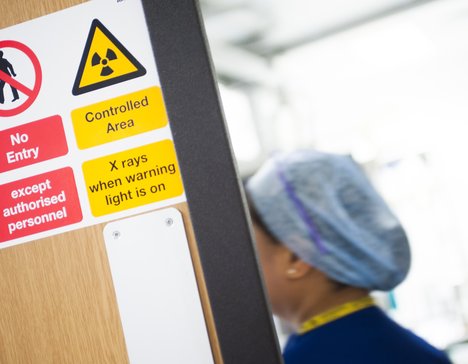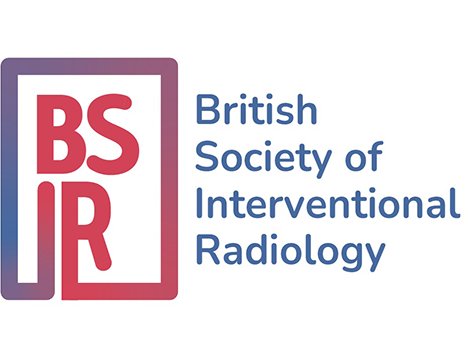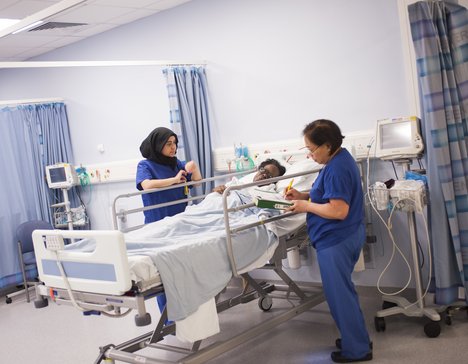Clinical Practice - Guidelines and Statements
Joint position statement on medical imaging exposure and radiation safety for patients
Background
In May 2021, the International Atomic Energy Agency (IAEA) published a joint position statement with a range of international organisations and professional bodies and call for action to strengthen radiation protection of patients undergoing recurrent radiological imaging procedures.
The IAEA highlighted the potential for automatic exposure monitoring systems to monitor cumulative dose at an individual patient level. The joint position statement proposed actions to address concerns over high cumulative doses from recurrent medical imaging including, identification of clinical conditions that require recurrent imaging and developing strategies in terms of the type of imaging and frequency. It also recommended the need for customised imaging protocols for these patients and use of the latest technology to help reduce patient dose. Further actions include strengthening radiation protection education and training of healthcare professionals and strengthening communication.
Notably, the joint position statement recommended that dose monitoring systems should be used to monitor the exposure history of individual patients using type of radiological procedure, estimated effective dose or patient-specific organ dose estimates. The joint position statement recommended where possible, clinical and radiation dose information from the patient’s previous imaging procedures needs to be made available to help strengthen the decision-making process when justifying a series of radiological procedures for a patient.
AAPM response
In response to the joint position statement, the American Association of Physicists in Medicine (AAPM), the American College of Radiology (ACR), and the Health Physics Society (HPS) published a policy on the use of dose metric tracking for medical exposures. The AAPM consider that the decision to perform a medical imaging exam should be based on clinical grounds, including the information available from prior imaging results, and not on the dose from prior imaging-related radiation exposures.
The AAPM advise that justification of the potential patient benefit and optimisation of medical imaging exposures are the most appropriate actions to take to protect patients from unnecessary medical exposures.
The AAPM recommends against using dose values, including effective dose, from a patient’s prior imaging exams for the purposes of medical decision making, as the use of cumulative effective dose may have a negative impact on patient care.
The UK Health Security Agency (UKHSA) and the British Institute of Radiology (BIR) recognise the benefits of exposure monitoring systems in the optimisation process, while noting that there is no IEC standard governing the estimation of effective dose. UKHSA and BIR support the views outlined by the AAPM that the decision to perform a medical imaging exposure should be based on clinical need rather than the dose from previous exposures. In exceptional cases, when planning multiple high dose interventional (or CT perfusion) procedures exposing the same area, over a short time period, and where deterministic effects are expected, previous dose information should also be considered in the justification and optimisation process.
To protect patients from unnecessary medical exposures, appropriate justification of medical imaging exposures is essential.
Optimisation of medical imaging exposures is one of the fundamental principles of the Ionising Radiation (Medical Exposure) Regulations and is required to keep doses from medical exposures as low as reasonably practicable, consistent with the intended purpose.
About The British Institute of Radiology
The British Institute of Radiology is an international membership organisation for everyone working in imaging, radiation oncology and the underlying sciences.
Our aims are to:
- support the work of our members and their colleagues to achieve professional excellence.
- provide continuing professional development for our multidisciplinary community
- publish cutting-edge research for our authors and readers across the world
- influence and connect with the wider professional sector.
Registered Charity No: 215869
About the UK Health Security Agency
The UK Health Security Agency is an executive agency, sponsored by the Department of Health and Social Care.
www.gov.uk/government/
Version 1.0
Prepared by: the Medical Exposures Group, UK Health Security Agency
For queries relating to this document, please contact: [email protected]
Published: 4 July 2023
You may re-use this information (excluding logos) free of charge in any format or medium, under the terms of the Open Government Licence v3.0. To view this licence, visit OGL. Where we have identified any third party copyright information you will need to obtain permission from the copyright holders concerned.
Carole Cross | Director of Communications and Partnerships
|
The British Institute of Radiology Audrey House, 16-20 Ely Place, London EC1N 6SN +44 (0)20 3668 2224 (please leave message and I will get back to you) | www.bir.org.uk Registered charity number: 215869 |
Download here
IR BLEEDING RISK GUIDANCE
Dear BSIR members,
Please find attached the BSIR bleeding risk guidance document.
This has been jointly produced by the BSIR Safety & Quality Committee in conjunction with the British Society of Haematology.
This is intended as an easy to use guide for IR teams.
The HEMSTOP screening questionnaire is designed to act as a pre-procedural screening tool rather than simply performing routine clotting screens on all patients, and has been widely supported by the British Society of Haematology. This is used by other surgical specialties and pre-operative assessment teams and we hope that this will guide future radiological practice in the UK.
The second half of the document is designed to guide the temporary cessation and restarting of an anticoagulant or antiplatelet medication for an IR procedure. This is a complex area to summarise and therefore intended to be used as a general guide for radiology teams, but may require engagement with referring or specialist teams when managing complex patients or for those patients who require bridging protocols.
We hope that this will be a useful guide for daily practice, streamlining processes in an attempt to avoid unnecessary tests, and we are keen to distribute this to the BSIR membership.
Many thanks
Best wishes
Dr Raj Das and Dr Clare Bent on behalf of the BSIR Safety and Quality Subcommittee
Any comments or correspondence please send to : [email protected] and [email protected]
IR BLEEDING RISK GUIDANCE FINAL BSIR BSH APRIL 2025 UPDATE
2021: Vascular research priorities survey round 2
It’s here! Vascular research priorities survey round 2 – please share with your patients
Dear BSIR members,
Please can you help to ensure your Vascular unit and your patients are represented by helping to promote the research prioritisation second round survey to your vascular patients and carers.
Patients with any vascular condition are invited to rate a list of proposed research questions, based on what is important to them. These questions were generated by patients and carers themselves in an earlier round of survey. They have been analysed, summarised and duplication removed, in preparation for this prioritisation round of survey.
What can I do to help? There are lots of ways you can help.
Share the survey:
Encourage your patients, their carers and families to complete and share electronic link: https://york.qualtrics.
A paper version and promotional materials can be downloaded directly from the project website: https://www.hyms.ac.
or you can email [email protected]
1. In a rush and want to help? Ctrl + click to send one of these tweets:
It’s here! Your chance to influence research in vascular
Vascular patients and carers help to prioritise future research
Encourage followers to share with ‘please RT’, tag your participating organisation such as @VSGBI @vascularnurses @svtgbi @VascResearchNet @BACPAR_official @BSIR_News
2. Post this message in relevant on-line forums and support groups:
The Vascular Research Priority Setting Partnership wants to hear from vascular patients, carers and family members. This is your chance to help inform future research so that it focuses on what matters most to those accessing vascular services. Complete the survey at: Vascular Research Priorities Survey
3. Use our posters and hard copies of the survey:
On our website, we have downloadable versions of posters and copies of the survey, that can be sent to us via email or post: https://www.hyms.ac.uk/r
The success of this project absolutely depends on the involvement of all UK vascular units and vascular specialists in helping us to reach as many different vascular patients as possible. We really appreciate your help.
Thank you for your support.
Transjugular Intrahepatic Portosystemic Stent-Shunt (TIPSS)
Guidance management of gas embolism
Please click HERE to view Management of Patients With Gas Embolism
New Guidance on Picture archiving and communication systems and guidelines on diagnostic display devices from the Royal College of Radiologists
Please click HERE to view RCR New Guidance on Picture archiving and communication systems and guidelines on diagnostic display devices
Paclitaxel Patient Letter V4040619 (1)
Dear BSIR Member
It is appreciated that the recent MDA from MHRA regarding drug eluting stents and drug coated balloons may mean that Trusts and departments want to write to/contact patients. To try to help reduce the potentially repetitive workload of formulating a letter, a group of IRs and Vascular Surgeons have put together the attached (click HERE to view). Undoubtedly individual organisations will want to produce their own version, or may not wish to write, but we offer the attached as a way to try to help. We hope you find it of assistance, if not, please feel free to ignore it.
Dr Trevor Cleveland
BSIR President
Global Vascular Guidelines
Please click HERE to view the Global Vascular Guidelines CLTI Guideline Published in June 2019
2018: NCEPOD Themes
Dear BSIR member,
I would like to commend to you, and suggest taking a few minutes to read, the attached.
This is the NCEPOD Themes and Recommendations Common to all Hospital Specialties.
It is a review of the most common recurring themes seen in the many NCEPOD Reports.
The entire document is relevant, but I would draw your attention specifically to 2 themes:
Theme 5 – Consent. Among the notes there is a very clear support of the GMC guidance on taking consent and who should do this. In elective cases a deferred two stage process is recommended and also that consent on the day is not seen as appropriate. This is a very clear statement of need for IR clinics for non-emergency care.
Theme 9 – Managed Clinical Networks. Again it has been clear that formal network arrangements need to be in place to allow patients to have access to the appropriate treatment. Ad-hoc arrangements are not considered suitable, and that Trusts need to have a clear refer and transfer policy. Again, I’m sure that this will ring in the ears of all of you, both in hubs and spokes, as there often in not a clear process for referral and transfer, leading to unnecessary delay (or even denial) of important IR procedures.
I am sure that there are a number of other areas in this document that you might find helpful in supporting your quality improvement programmes.
Best wishes
Trevor Cleveland
BSIR President
NCEPOD Common Themes
NICE Guidance for Prostate Artery Embolisation (PAE)
NICE Guidance for Prostate Artery Embolisation (PAE)
Mechanical Thrombectory for Ischaemic Stroke
Training to deliver mechanical thrombectomy
In order to achieve the desired delivery of a 24/7 service in MT across England, the number of operators capable of contributing to MT services needs to expand more rapidly than will be achieved by current INR trainee numbers. This means training other specialists to perform MT.
The British Society of Neuroradiologists (BSNR) has produced “Training guidance for mechanical thrombectomy” (Lenthall R, McConachie N, White P, Clifton A, Rowland-Hill C. BSNR training guidance for mechanical thrombectomy. Clin Radiol 2017; 72(2): 175.e11–175.e18.) which details the training that will be required for practitioners from different clinical backgrounds to achieve the necessary skills and experience to effectively contribute to the acute stroke service. This guidance will underpin all routes to increasing the workforce.
https://www.rcr.ac.uk/clinical-radiology/being-consultant/mechanical-thrombectomy-ischaemic-stroke
NHS Reference Cost Collection 2016/17
NHS have now published this year’s reference cost collection (2016/17 costs) all the spreadsheets and supporting documentation can be found HERE
2017: Analysis of Thrombolysis in acute DVT Surveys
Dear Colleagues,
I would like to offer my sincere apologies for the delay in the publication of the analysis of my two recent Surveys about Thrombolysis in acute DVT and the second on the possible reasons behind not providing this service. Also, I would like to thank those who participated in these surveys.
Since the introduction of NICE guideline* for Thrombolysis in acute Ilio-Femoral DVT in 2012, a selection of Interventional radiologists (IR) started providing this form of treatment to patients with a history of DVT of less than 2 weeks’ duration.
The second survey showed that several IR’s colleagues have shown an interest in providing this form of treatment even though a small number (22%) are put off by the recent presentation of ATTRACT trial which claimed that there was no benefit in acute DVT thrombolysis in terms of preventing Post Thrombotic syndrome (ATTRACT fails to meet primary endpoint, but experts agree results are “hypothesis-generating” Vascular News 6th March 2017).
The purpose of both surveys is to pave the way to establish a registry on Thrombolysis in acute Ilio-Femoral DVT sponsored by BSIR. The surveys show that a number of Interventional radiologists and vascular surgeons, albeit small, do offer both Mechanical and or Catheter directed Thrombolysis.
As you can see from my summary report below, we are all providing the recommended pathway of treatment and utilizing available technologies to achieve the best outcomes. However, to gain some insight into the efficacy of these techniques, I would recommend a formal registry, run by the BSIR. I would recommend at least two years’ follow up. In addition, the registry is going to be used as a tool to determine how we define a successful primary outcome (i.e. preserved valve function, speed of flow, absence of reflux and whether there is a residual clot or stenosis) and whether this translates into good medium to long term outcomes.
Meanwhile, there are two controversial issues which require a consensus. The first issue is related to the use of IVC filter prior to thrombolysis and rather than putting my views on this topic I would like to share with you several publications on this issue which are worth reading:
PREPIC-1 (Decousus et al. A clinical trial of vena caval filters in the prevention of pulmonary embolism in patients with proximal deep vein thrombosis. NEJM 1998; 338:409)
PREPIC-1 Follow-Up Study (Eight-year follow-up of patients with permanent vena cava filters in the prevention of pulmonary embolism. Circulation 2005; 112: 416-422)
PREPIC-2 (Effect of a retrievable inferior vena cava filter plus anticoagulation vs. anticoagulation alone on risk of recurrent pulmonary embolism: A randomized clinical trial. JAMA 2015; 313: 1627)
Prasad V, Rho J, Cifu A. The IVC Filter: How could a medical device be so well accepted without any evidence of efficacy? JAMA Internal Medicine 2013; 173(7) 493-495.
The second issue which is equally very important and is to do with the future follow up of our patients following thrombolysis and whose responsibility it is.
Please, enjoy reading the analysis of the surveys’ outcomes and don’t hesitate to reply with your invaluable thoughts and suggestions on what questions should be included in any planned future registry.
Best wishes
Said Habib
Consultant IR, Nottingham University Hospitals
*NICE guideline:
Deep vein thrombosis
1.2.6Consider catheter-directed thrombolytic therapy for patients with symptomatic iliofemoral DVT who have:
- symptoms of less than 14 days' duration and
- good functional status and
- a life expectancy of 1 year or more and
- a low risk of bleeding. [2012]
NICE Guidance CG147 update
Updates on national tariff related publications from NHS Improvement
Enquiries and frequently asked questions
NHS Improvement now publish the queries they receive on the national tariff. The 2016/17 enquiries log now updated with questions and FAQs up to January and this can be found here:
https://www.gov.uk/government/publications/nhs-national-tariff-payment-system-201617
NHS Improvement have also launched the 2017/19 document with a selection of FAQs, that document can be found here:
https://improvement.nhs.uk/resources/national-tariff-1719/
Tariff doc corrections
NHS Improvement have updated a number of documents on the 2017/19 webpage due to small errors. The main national tariff has had a date correction made in paragraphs 271 and 272 (relating to MFF recalculation). They have corrected a column header issue on the MFF page of the national prices spreadsheet and further to feedback have removed the non-mandatory price for adult hearing services from the non-mandatory prices spreadsheet. The documents can all be found here:
https://improvement.nhs.uk/resources/national-tariff-1719/
Reference cost collection guidance.
NHS Improvement have now published the reference cost guidance for 2017, it can be accessed here:
https://improvement.nhs.uk/resources/approved-costing-guidance/
Whole population budget webinars.
Following NHS Improvement latest webinar on new payment approaches, a page as been set up to bring all of the webinars on the subject together. This will be added in the next month or so with further material.
https://improvement.nhs.uk/resources/whole-population-budgets/
Letter to members and medical directors re IR data submission to NVR 2016
Please see below a position statement from the BSIR about time allocation (in job planning) and administrative support for IR data entry into NVR. We hope that members may find this useful in negotiations with trust management over these issues.
Yours faithfully,
Chris Hammond
Chair: BSIR R&A Committee
Letter to members and medical directors re IR data submission to NVR 2016
Benchmarking Consent in Nephrostomy
Please see below a survey of nephrostomy outcomes (also performed earlier in 2016), which we hope may aid you in benchmarking your practice and assisting in consent processes.
Chris Hammond
Chair: BSIR R&A Committee



